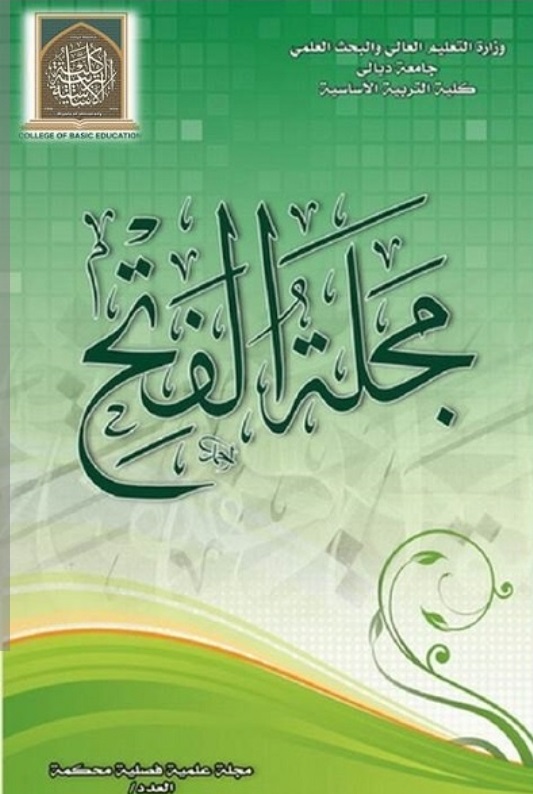Fear of Crime among Preparatory School Teachers
Keywords:
Fear of CrimeAbstract
1- Fear of Crime among Preparatory School Teachers.
2- Significance of statistical differences among middle school teachers according to the gender variable (male-female) and the geographical location (urban-rural)
To achieve the aims of the current research, the researcher built the( Fear of Crime scale) according to the theory and definition (Hindlank ,et al,1978) after following the scientific steps in its construction, verifying the virtual honesty, and the sincerity of the construction, and verified the stability in the method of retesting reaching the stability factor (0.87), while the stability factor in the Manner of Alpha-Cronbach (0.90). The scale were applied to the main research sample consisting of (400 male and female) researchers selected in a random class manner with a proportional distribution From Baquba district and its environs (Al-Markaz, Kanaan, Bani Saad, Buhriz, Al-Abara) .The data of the study was statistically processed using (T-test for one sample, Pearson correlation coefficient. T-test of two independent samples, Alpha-Cronbach equation).
The research reached the following conclusions:
1- The members of the research sample have the aspect of, Fear of Crime.
2- Fear of crime is affected by gender (male - female), as it is in favor of males and is more homogeneous.
3- Fear of crime is not affected by the geographical location (urban - rural), as it is the same for both.
In the light of these findings, the current research has reached a number of recommendations and suggestions.
References
اولا: المصادر العربية.
ابو علام، رجاء محمود(۱۹۸۹). مدخل الى مناهج البحث التربوي، ط1، مكتبة الفلاح، الكويت.
ألبياتي، أنتصار زين ألعابدين (٢٠٠٦).الكفايات التدريسية لمدرسي التربية الإسلامية في المرحلة الإعدادية، مركز البحوث النفسية والتربوية ، العدد (۱۱) ، جامعة بغداد ، العراق.
البداينة، ذياب ( 2000 ). أثر المتغيرات الشخصية وإدراك مخاطر الجريمة وخبرة الضحايا في الخوف من الجريمة، مجلة جامعة عدن للعلوم الاجتماعية والإنسانية، ص7-26.
ثورندايك روبرت وهيجين اليزابيث (۱۹۸۹). القياس والتقويم في علم النفس والتربية، ترجمة الكلابي عبدالله زيد ،وعدس وعبد الرحمن، وركز الكتاب الأردني، عمان، الأردن.
جيطان، محمد يعقوب رشدي(2014). إدراك الخوف من الجريمة بين أرباب وربات البيـوت فـي مينـة نابلس. (رسالة ماجستير منشورة)، فلسطين، جامعة القدس، كلية الآداب، دائرة الخدمة الاجتماعية، ص1-150.
الخرابشة، عمر محمد عبدالله (۲۰۰۷). اساليب البحث العلمي، دائرة المطبوعات والنشر، جامعة البلقاء التطبيقية الاردن.
المنيزل ، عبد الله فلاح والعتوم ، عدنان يوسف ( ۲۰۱8) . مناهج البحث في العلوم التربوية والنفسية ، عمان، دار الميسرة للطابعة والنشر، ص1-400.
ثانياً: المصادر الاجنبية.
Ahman, Clock, H. (1971). Uequring and Evaluation educational Achierement, boston, Ally nana bacon.
Anastasi, Anne (1976). Psychological testing, New York, mac Malian Psychological.
Anderson, K., Smith, S., (2001).Emotional geographies, Transactions of the Institute of British Geographers 26, 7-10.
Cronbach J.(1970) Essentials of psychological testing, New York: Harper & Row.
Hindlank, M., Gattfredson, M. & Garofalo, J. (1978). Victims of personalcrime: An empirical foundation for theory of personal Victimization Cambridge: ballinger,p: 309 - 324.
Killias, M. (1991). Towards a better understanding of a key variables in the genesis of fear of crime. Violence and Victims, 5 (2), pp: 97-108 .
Lash, S. (1993) 'Reflexive modernization: the aesthetic dimension', Theory, Culture and Society, 10: 1-23.
Maxfield, M.G. (1984) Fear of Crime in England and Wales. London: Her Majesty's Stationery Office,p:1 - 51.
Downloads
Published
How to Cite
Issue
Section
License
Copyright (c) 2024 مجلة الفتح للبحوث التربوية والنفسية

This work is licensed under a Creative Commons Attribution 4.0 International License.
حقوق النشر والترخيص
تطبق مجلة الفتح للبحوث التربوية والنفسية ترخيص CC BY (ترخيص Creative Commons Attribution 4.0 International). يسمح هذا الترخيص للمؤلفين بالاحتفاظ بملكية حقوق الطبع والنشر لأوراقهم. لكن هذا الترخيص يسمح لأي مستخدم بتنزيل المقالة وطباعتها واستخراجها وإعادة استخدامها وأرشفتها وتوزيعها ، طالما تم منح الائتمان المناسب للمؤلفين ومصدر العمل. يضمن الترخيص أن المقالة ستكون متاحة على نطاق واسع بقدر الإمكان وأن المقالة يمكن تضمينها في أي أرشيف علمي.
لمزيد من المعلومات، يرجى متابعة الرابط: https://creativecommons.org/licenses/by/4.0/.


